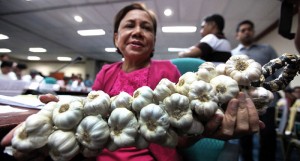
GARLIC TRADERS EARNING BILLIONS Holding a string of expensive bulbs, Sen. Cynthia Villar, chair of the Senate agriculture committee, says the surge in the price of imported garlic from P17 to P300 a kilo could translate to a profit of P26 billion a year for traders. The P2-million penalty for price manipulation is not deterring them. CONTRIBUTED PHOTO
DAGUPAN CITY—Enraged by the unprecedented increase in garlic prices, a group of agriculture stakeholders on Friday demanded the immediate resignation of Bureau of Plant Industry (BPI) Director Clarito Barron, saying he was to blame for the mess.
Rosendo So, president of Samahang Industriya ng Agrikultura and chair of the Abono party-list group, said BPI’s issuance of permits to import garlic was “suspicious” because it was timed with the local garlic harvest season.
“He wants to kill the local garlic industry. This was exactly what he did with onions. He allowed importation as we were harvesting our crops,” So said.
“If every time we harvest our local garlic, we also import, this will kill our farmers and the garlic industry because the importation price is only P17 per kilogram, plus a 40-percent tariff,” he said.
So said that in 1990, annual local garlic production was 17,848,870 kg and the demand was about 40 million kg per year.
Reached by the Inquirer for comment, Barron said the role of his bureau was ministerial. He said the volume of imports was decided by the National Garlic Action Team in which farmers’ groups, traders and local government units have a role.
“Now we produce only about 8.84 million kg per year. If our demand is 100 million kg per year, it means that we are only producing 8 percent of the total demand,” So told the Inquirer in a phone interview on Friday.
Last month, garlic prices at the wholesale market in Urdaneta City ranged from P200 to P250 per kg, depending on the size. A week later, they shot up to P280 per kg.
In an earlier interview, Paz Mones, assistant regional director of the Department of Agriculture in San Fernando City, La Union province, said that during the harvest in April and May, traders bought garlic in the Ilocos provinces at P90 per kg. Traders then sold these, she said, at P140 per kg.
The Ilocos region produces 65 to 68 percent of the country’s total garlic production. But Mones said this was only about 6.5 million kg, which, she said, was not much.
“Prices actually increased when the stocks were no longer in the farmers’ hands,” Mones said.
So said the same traders who were allowed to import bought the local garlic, enabling them to manipulate the prices.
“We have no garlic shortage. There’s a lot out there. It’s just that they are expensive,” So said.
He said less than 15 percent of the country’s garlic supply was produced locally. “The bulk of supply (85 percent) is in the hands of the few importer-traders that were issued import permits,” he said.
“The dramatic increase in garlic prices in recent days is the expected catastrophe resulting from this failed policy of overreliance on imports and unabated smuggling for the country’s food needs,” So said.
In the case of garlic, So said imported garlic was bought by importers at a lower price—P17 per kg in landed cost—as compared to P100 to P120 per kg in farm-gate prices of local garlic. Traders hoarded the cheaper imports to dampen supply, raised prices and released garlic to the market when prices are at their peak.
“When the local competition has been eliminated or reduced to insignificance, importers, smugglers and unscrupulous traders, who now have monopoly control, can dictate prices,” So said. Gabriel Cardinoza, Inquirer Northern Luzon, with reports from Rafael Antonio, Inquirer Research, and Ronnel Domingo in Manila